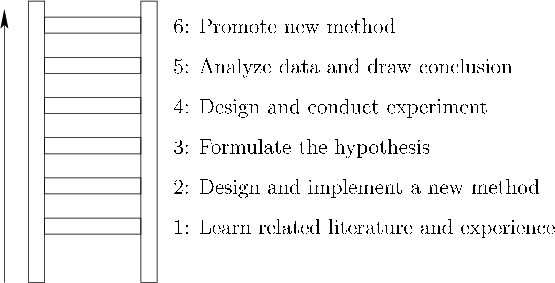
Next: Human subjects Up: 12.4 Experiments on Human Previous: 12.4 Experiments on Human Contents Index
 |
The scientific method has been around since ancient times, and continues to be refined and improved in particular sciences. Figure 12.4 depicts how it could appear for VR development. Imagine trying to climb a ladder. The first step is accomplished by studying the appropriate literature or gaining the background necessary to design a new method that is likely to be an improvement. This will reduce the chances of falling from the ladder. The second step is to design and implement the new method. This step could include some simple evaluation on a few users just to make sure it is worth proceeding further.
The third step is to precisely formulate the hypothesis, regarding how it is an improvement. Examples are: 1) a reduction in adverse symptoms, 2) improved comfort, 3) greater efficiency at solving tasks, 4) stronger belief that the virtual world is real, and 5) a greater enjoyment of the activity. It often makes sense to evaluate multiple criteria, but the result may be that the new method is better in some ways and worse in others. This is a common outcome, but it is preferable to failing to improve in any way! The hypothesis could even involve improving future experimental procedures; an example is [60], in which researchers determined cases in which physiological measures are better indicators of VR sickness than questionnaires. Finally, the hypothesis should be selected in a way that simplifies the fourth step, the experiment, as much as possible while remaining useful.
For the fourth step, the experiment should be designed and conducted to test the hypothesis. The fifth step is to analyze the data and draw a conclusion. If the result is a ``better'' method in terms of the criteria of interest, then the six step is reached, at which point the new method should be presented to the world.
At any step, failure could occur. For example, right after the experiment is conducted, it might be realized that the pool of subjects is too biased. This requires falling down one step and redesigning or reimplementing the experiment. It is unfortunate if the conclusion at the fifth step is that the method is not a clear improvement, or is even worse. This might require returning to level two or even one. The key is to keep from falling too many steps down the ladder per failure by being careful at each step!
Steven M LaValle 2020-01-06